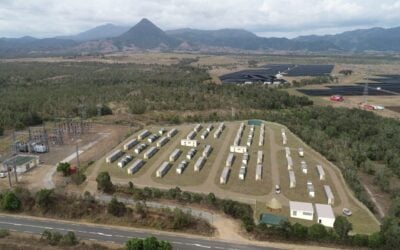Boyle was speaking at Solar Media’s Solar Finance and Investment conference in London. Image: David Pratt/Solar Media.
Secure financing for energy storage is likely to be the main driver for its deployment, the chief of the UK’s biggest solar developer has said, echoing views given to Energy Storage News by analysis firm Lux Research.
Speaking at the Solar Finance and Investment UK conference, taking place for three days this week and hosted by Energy Storage News’ publisher, Solar Media, Nick Boyle, Lightsource Renewable Energy’s CEO said that investing in solar and batteries for solar “in the very near future” was “exactly where the focus should be”.
“We’re at a stage where we [solar PV] can compete with daytime electricity prices but batteries are nearly there. We’re nearly in a position where solar and batteries offer base load technology at a price that works and can compete with anything, and that’s a wonderful place,” Boyle said.
While many are focusing on possible advances in technologies and battery chemistries, and these areas generate media and industry interest alike, analyst Cosmin Laslau of Lux Research recently told Energy Storage News that news ways to finance storage as a long term proposition could drive the market on even faster over the next couple of years.
Try Premium for just $1
- Full premium access for the first month at only $1
- Converts to an annual rate after 30 days unless cancelled
- Cancel anytime during the trial period
Premium Benefits
- Expert industry analysis and interviews
- Digital access to PV Tech Power journal
- Exclusive event discounts
Or get the full Premium subscription right away
Or continue reading this article for free
“We’re not seeing any major breakthroughs coming up in the near term that will rock the industry in terms of cost reductions for energy storage. Probably the much more important thing will be financing arrangements and realising that in certain geographies, you want to deploy as many batteries as possible with financing because these are projects that can make sense for everybody involved in that deal and start to generate some pretty good revenues,” Laslau said.
“…What’s really going to drive the bulk of activity in getting to the next level of deployment is going to be financing and new business models.”
Laslau said that being able to finance projects either through investment or borrowing over the lifetime of their operation would be the key, with analytics reporting and assessing system performance becoming increasingly important.
Lightsource’s Nick Boyle, whose company says it will be executing its first tranche of UK solar farms without subsidies this year, said at the conference that he and his company will be seeking ways to offer that secure investment.
“I’m about trying to create securitisable revenue streams and I think batteries, if they’re priced properly and projected forward for the term of the solar, are a viable option because they’re able to say to an entity ‘we can supply all of your electricity needs rather than just the stuff that we’re able to produce while the sun shines’,” Boyle said, “…so it’s a natural progression”.
From millions to billions
Image: Lightsource.
However, Laslau, whose team covers the international battery and energy storage industry for Lux, said that so far these instruments are in their infancy, looking to two specific examples from California’s mandate-driven energy storage market.
“What we’re seeing are a handful of companies like Stem and Green Charge Networks that are focused on some pretty specific applications at the start that make a lot of sense in terms of payback. You might be limited to California, you might be limited to a commercial customer of a certain size, so that means that you’re probably talking about a couple of hundred million dollars in terms of financing.”
Moving forward from that will require storage to become as ‘mainstream’ as solar has become, Laslau stated, using the example of the US rooftop leasing market.
“The next level, if we’re talking an order of magnitude large investment – when are we going to see billions of energy storage financing become available and be taken up? Then we probably need to start thinking about residential, will a company like SolarCity start to deploy massive amounts of solar-plus-storage for its customers, financed, when is that going to happen?”
Laslau said it might not happen this year and that some more cost reduction might be needed, as well as some expansion of scale and longer track records by the industry’s leaders for investors and financiers to examine. However, he was confident that “there’s a definite point in the future when that will be achieved”.
Additional reporting by David Pratt.





